| Download and install the indispensable font(s) to view Sanskrit in its full glory Read Transliterating (2) (English) to fully understand the transliteration system |
Learning Sanskrit - First strokes 2
Drawing Sanskrit consonants
Introduction
This document has been published as a support for Writing. In Writing, you learnt how to write in Sanskrit. Now, you will learn how to draw every letter properly. Apart from the well known letters, you will learn how to draw a number of important Conjuncts.
In First Strokes --Part 1--, you learnt how to draw Sanskrit Vowels. Now, in First Strokes --Part 2--, you will learn how to draw Sanskrit Consonants. It will be very easy and funny. The same rules you followed to draw vowels are to be followed when you draw consonants. No mystery about this.
Very important: The horizontal line in Sanskrit is always drawn in the end. In short, you write all characters comprising a word or a compound, and lastly you draw the horizontal line. However, when you draw a single letter or conjunct with some strokes on top of the horizontal line (e.g. "ai"), you will draw those strokes in the end. Still, the horizontal line is generally drawn when you finish writing. Why? Because it would be really annoying to draw a short horizontal line for every character, and then to join these lines together.
Therefore, when you draw a single character with some strokes on top of the horizontal line, it is OK to draw those strokes in the end (after the horizontal line). Nevertheless, remember always that when you write words and compounds, you must draw the horizontal line in the end. Got the point? Well done.
Drawing Gutturals, Palatals, Cerebrals, Dentals and Labials
Sanskrit language is written from left to right, just as English is. No problem about it. The order of each stroke is designated by a number. Follow the numbers the same way as you did when drawing Sanskrit vowels, and enjoy yourself. Have the Alphabet at hand.
Let's get down to work.
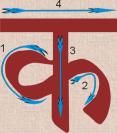 |
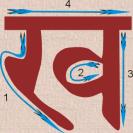 |
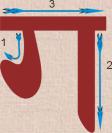 |
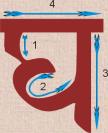 |
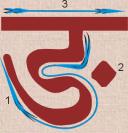 |
|
ka (The strokes 1 and 2 are really just one stroke which has been divided into two for the sake of convenience. Remember this.) |
kha No comments |
ga No comments |
gha (The strokes 1 and 2 are really just one stroke which has been divided into two for the sake of convenience. Remember this.) |
ṅa (Although the stroke 2 looks like a diamond --due to the pen being used--, it is really a simple dot.) |
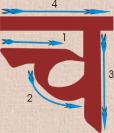 |
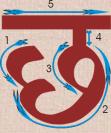 |
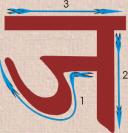 |
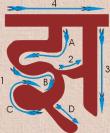 |
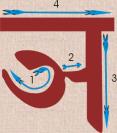 |
|
ca (The strokes 1 and 2 are really just one stroke which has been divided into two for the sake of convenience. Remember this.) |
cha (The strokes 1, 2 and 3 are really just one stroke which has been divided into three for the sake of convenience. Remember this.) |
ja No comments |
jha (The stroke 1 is a single stroke composed of four sub-strokes --A, B, C and D--. This division has been done for the sake of convenience.) |
ña No comments |
 |
 |
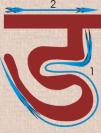 |
 |
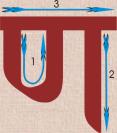 |
|
ṭa No comments |
ṭha No comments |
ḍa No comments |
ḍha No comments |
ṇa No comments |
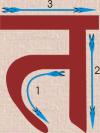 |
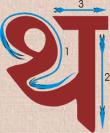 |
 |
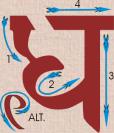 |
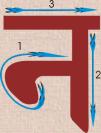 |
|
ta No comments |
tha No comments |
da (The stroke 1 is a single stroke composed of three sub-strokes --A, B, and C--. This division has been done for the sake of convenience.) |
dha Although the stroke 1 has a strange beginning here (a very short horizontal line), it is simply a curve just as the stroke 1 in "Gha". Sometimes it is also drawn with a curl (See ALT. stroke below the character.) |
na No comments |
 |
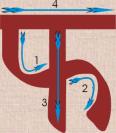 |
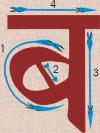 |
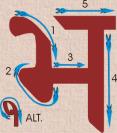 |
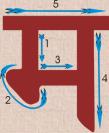 |
|
pa No comments |
pha (The strokes 1 and 2 are really just one stroke which has been divided into two for the sake of convenience. Remember this.) |
ba No comments |
bha (Sometimes, the stroke 1 is also drawn with a curl --See ALT. stroke below the character--. Of course, strokes 1, 2 and 3 are just one stroke. The thick area formed from stroke 2 is really a triangle. You will realize this when drawing the character.) |
ma (The strokes 1, 2 and 3 are just one stroke. The thick area formed from stroke 2 is really a triangle. You will realize this when drawing the character.) |
Drawing Semivowels, Sibilants and Sonant Aspirate
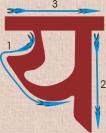 |
 |
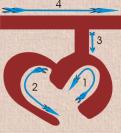 |
 |
|
ya No comments |
ra No comments |
la (The strokes 1 and 2 are really just one stroke which has been divided into two for the sake of convenience. Remember this.) |
va No comments |
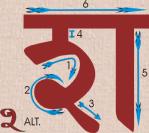 |
 |
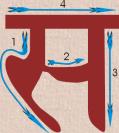 |
 |
|
śa The strokes 1, 2 and 3 are really just one stroke which has been divided into three for the sake of convenience. Remember this. Sometimes, these very strokes are drawn as shown in the ALT. stroke, and no stroke 4 --connector-- is used, i.e. this kind of 2 directly touches the horizontal line, this way: 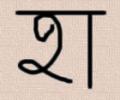 |
ṣa No comments |
sa No comments |
ha No comments |
Concluding remarks
This document is finished. It has been a simple task. Keep practicing and in due course you will be drawing Sanskrit characters in a very spontaneous manner. Each stroke follows a definite pattern. No mystery about it.
Next time, I will teach you how to draw the major Sanskrit Conjuncts. Keep learning Sanskrit and have fun.
Further Information
This document was conceived by Gabriel Pradīpaka, one of the two founders of this site, and spiritual guru conversant with Sanskrit language and Trika philosophy.
For further information about Sanskrit, Yoga and Indian Philosophy; or if you simply want to comment, ask a question or correct a mistake, feel free to contact us: This is our e-mail address.





























